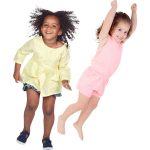 According to the National Institute of Mental Health, about 40 million Americans suffer from some form of anxiety. Not only is it the most common mental health issue in the U.S., it’s also the most prevalent worldwide.
According to the National Institute of Mental Health, about 40 million Americans suffer from some form of anxiety. Not only is it the most common mental health issue in the U.S., it’s also the most prevalent worldwide.
We might think of stress and anxiety as “adult stuff” that couldn’t possibly affect the blissful, innocent life of a toddler. Unfortunately, anxiety can set in early, making it difficult for a young child to feel calm in certain situations.
Natasha Daniels, child therapist and author of How to Parent Your Anxious Toddler, reminds us that we’re not trying to eliminate anxiety, but we do want to teach children how to cope with it. She also explains that anxiety comes along with some truly wonderful characteristics. Anxious kids tend to be empathetic, intelligent, sensitive, and kind-hearted, and these positive traits can really shine through when they learn how to manage their anxiety. That’s why it’s so important for us to be able to identify and treat anxiety disorders in early childhood.
Highlights:
|
Here’s a list of common signs and symptoms that toddlers will display when suffering from high levels of anxiety.
Inflexible with Routines
Toddlers crave routines. Generally, having a daily routine gives them a sense of control and provides structure. However, becoming too attached to a routine can be a sign of anxiety. They might need to sit in a specific chair, sip from a particular cup, or be tucked-in in a certain way. There may be signs of separation anxiety in non-threatening situations, like when a primary caregiver leaves a room unexpectedly. Toddlers who are inflexible or lack a willingness to adapt to small changes in their routine might be experiencing anxiety.
Intense Fears and Phobias
It’s important to note the difference between common childhood fears and anxiety. It’s common for toddlers to have fears about things like loud noises, bugs, or even the bath. But intense anxiety or even phobias can sometimes develop. For instance, a toddler might be afraid of dogs but can enjoy playing outside until they see one. However, if a toddler is so fearful of dogs that they can’t play outside or enjoy a short walk with a caregiver, that could be a symptom of intense anxiety stemming from that fear.
Repetitive Behaviors
Anxious children will sometimes develop repetitive behaviors, such as biting nails, twirling hair, clenching fists, tugging at clothes, or rubbing eyes. Even if a toddler seems to be relaxed, seeing these behaviors over and over again can be a sign of stress.
Sleep Issues
Almost every toddler will struggle with sleep at one point or another. Whether it’s difficulty falling asleep or staying in their “big kid” bed, sticking to a healthy sleep schedule isn’t always easy. However, an anxious toddler may wake up several times a night and seek the help of a parent or caregiver.
Regression
Falling back into old habits or showing signs of regression are also key red flags of toddler anxiety. Experts warn that this is especially true when it comes to potty-training. Toddlers that were previously potty-trained but suddenly have frequent accidents might be experiencing anxiety.
Sensitivity to Noise
Loud noises can also be a trigger for a stressed toddler. You may have noticed your toddler covering their ears when they hear a garbage truck, a vacuum, or a hair dryer. Sensitivity to noise can make a toddler feel apprehensive about being in big crowded spaces as well.
Physical Pain or Discomfort
Anxiety can take its toll on a toddler’s tiny body. Tension and stress can make a toddler lose their appetite, become constipated, or cause other aches and pains. Child psychologists often tell parents and caregivers to be aware of any chronic pain complaints, especially if it involves an upset tummy.
Remember that it’s common for toddlers to feel nervous or fearful. But when these feelings of anxiety stop them from trying new things or enjoying their daily activities, it may be time to seek the support of a professional. If you think your toddler is experiencing high levels of anxiety, talk to your pediatrician for guidance.








